We may receive a commission when you use our affiliate links. However, this does not impact our recommendations.
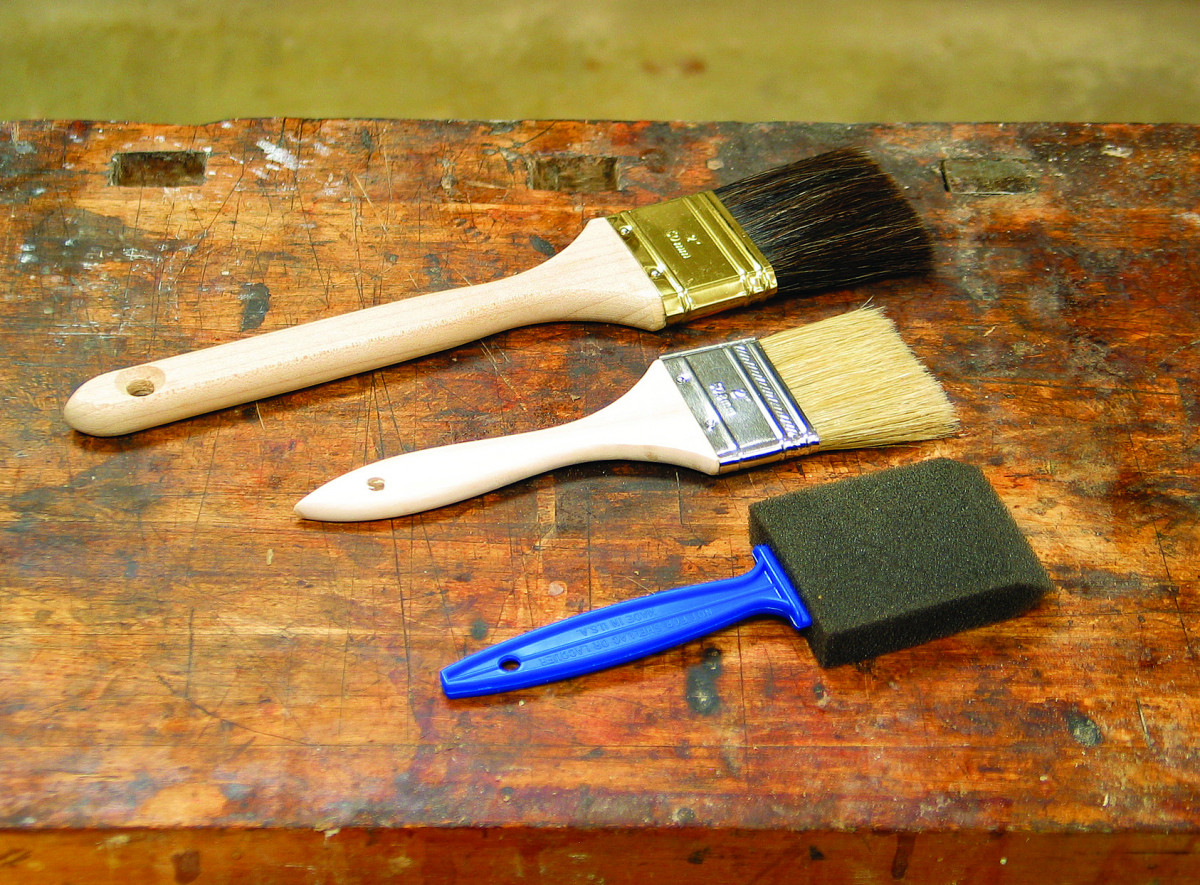
Brush differences. Brushes differ in their ability to keep their bristles from falling out, in the amount of finish they can carry and in their comfort. More expensive brushes, such as the oxhair brush (top), don’t reduce brush marks noticeably over the very cheap chip brush (middle), or the foam brush (bottom). The finishes themselves differ in how well they flatten out.
Putting some sense back into a simple task.
For most people, the first experience brushing comes with oil or latex paint, or with alkyd or polyurethane varnish. Each of these coatings is relatively easy to brush.
Paint is easy because it doesn’t have to go on perfectly; brush marks and other minor flaws are expected and accepted. Varnishes are easy because they dry slowly, so there’s plenty of time to spread them out evenly and get the brush strokes lined up with the grain.
Polyurethane varnish is the finish most widely brushed by amateur woodworkers, and it is the finish that is almost always used in instructions on how to brush (see The 7 Myths of Polyurethane.) There are countless articles, several videos, and even segments of television ads that describe or demonstrate how to brush varnish.
For a reason I don’t understand, almost all of these instructions suggest or show brushing slowly, several at the incredibly slow speed of eight seconds per foot. (Try it; I’ll bet you can’t brush this slow the first time).
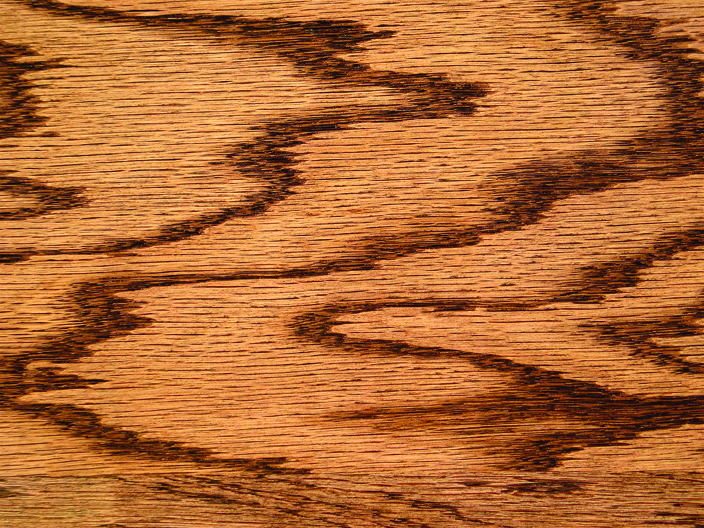
Reflected light. When there’s no light reflected in the surface (above), you can’t see problems as they develop. Move your head to pick up a reflection from some light source so you can see what’s happening – for example, the runs and sags in this finish (below). Once you see a problem, it’s usually easy to fix, most often by brushing back over the surface.

There was even a recent TV ad from a major finish supplier that showed brushing the entire width of a tabletop only 1′ in from the end of the boards (to be followed presumably by the next foot, which would leave a distinct overlap) instead of using long strokes running the length of the top.
Though this method is counterintuitive, and most people will figure out very quickly that it produces unacceptable results, the authority presented by TV and a brand-name company can’t help but lead some people astray. (For example, a senior salesman from a major paintbrush manufacturer came to my shop once and used this method while we were trying out different brushes.)
Though it’s also somewhat counterintuitive, many instructions suggest brushing across the grain, or diagonal to it, before lining up the brush strokes with the grain. Other instructions caution against shaking the finish, or even stirring it, because this will introduce air bubbles.
Brushing is very simple, actually intuitively simple. It shouldn’t require a magazine article like this one to put common sense back into the process.
The Basic Rule
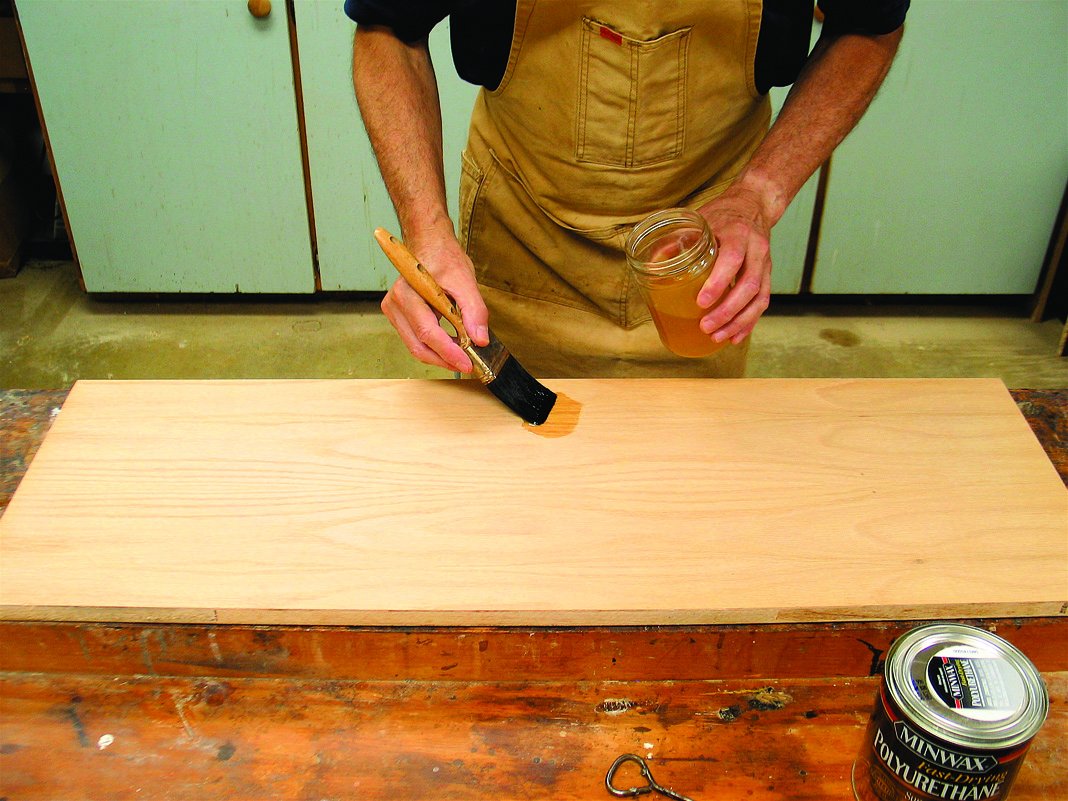
Depositing finish. Unless you have a reason to remove some of the finish from your brush, there’s no point in dragging it over the lip of the container or tapping it against the sides. The most efficient method of transferring finish to a large surface is simply to deposit a brush load onto the work.
The most critical rule for achieving good results, and the rule you almost never see, is to watch what you’re doing in a reflected light. This rule holds for spraying just as it does for brushing.
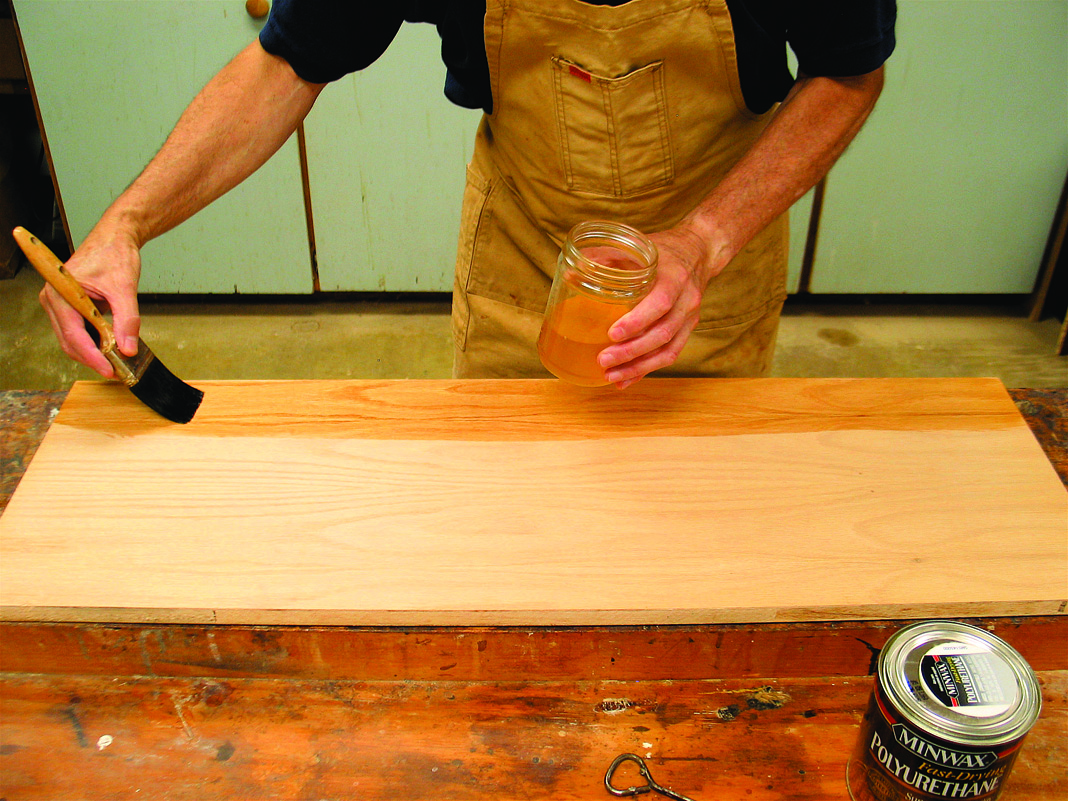
Stretching finish. Once you have some finish transferred to the work, stretch it end to end. If you need more finish to reach the ends, add more. It’s best to pour some finish into another container from the original, so if you should introduce some dirt you won’t have contaminated your entire supply.
You can see what’s happening in a reflection, and you can’t see if there isn’t one. As long as you see a problem as it occurs (usually a run, sag, drip or bubbles), it is usually easy to fix simply by brushing back over the surface.
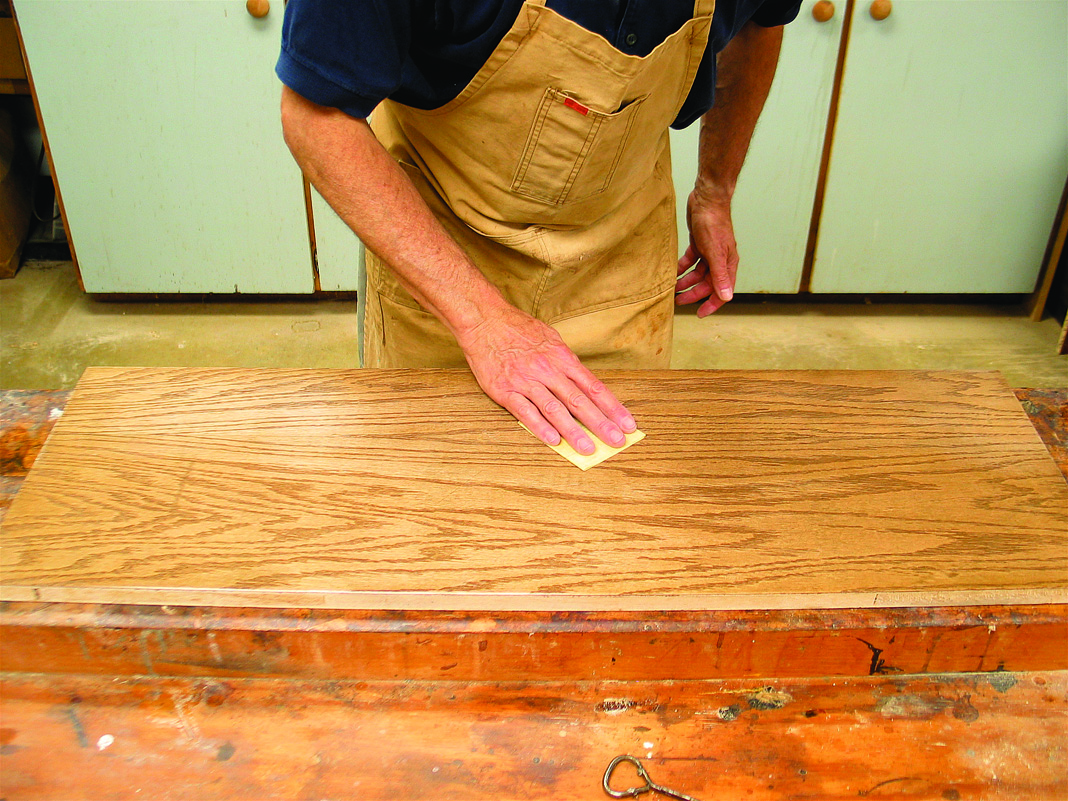
Sand between coats. No matter which finish you’re brushing, it’s almost always best to sand between coats to remove dust nibs. In most cases #320- or #400-grit sandpaper works well.
Bristles or other trash that may have fallen into the finish are also easy to spot in a reflected light, and they’re easy to remove with the tip of the brush or a small tool such as a toothpick. The damage done to the finish can then be repaired by brushing back over.
The Procedure
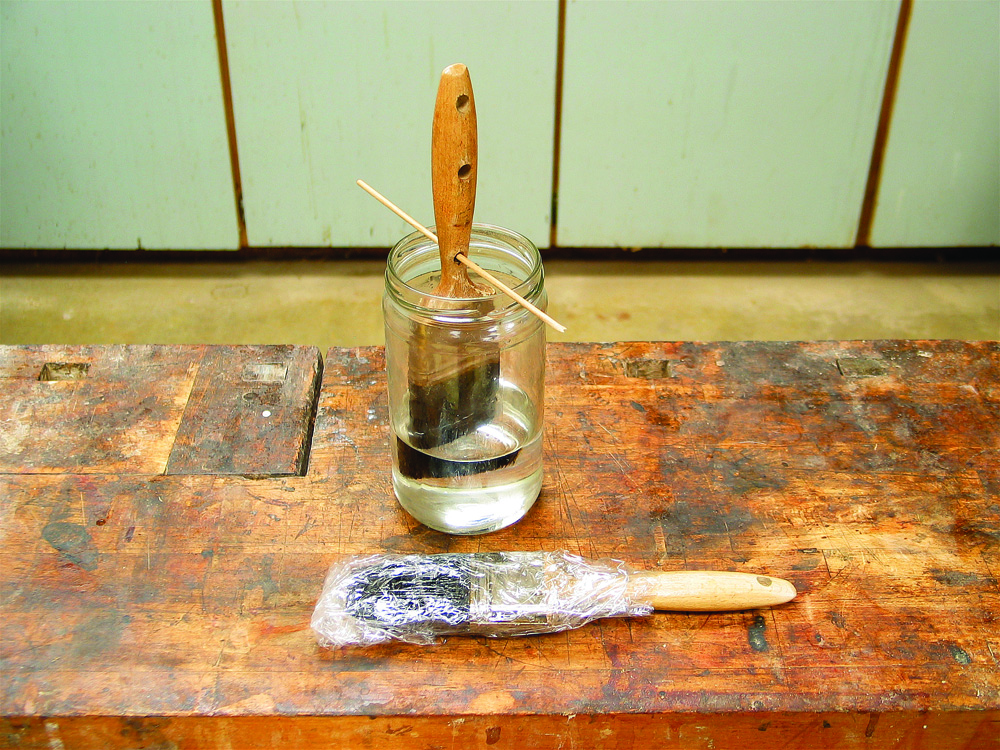
Storing brushes. If you are using a brush almost every day, you can store it by hanging the brush in the solvent for the finish or by wrapping the brush in plastic wrap. Notice the holes in the brush handle for suspending it in different-sized jars. You shouldn’t let the bristles rest on the bottom for any length of time or they will adopt a permanent curved shape.
No matter which finish you’re using, the procedure for brushing is the same. The only difference is you have less time with faster-drying finishes, such as shellac and water-based finish.
On any given object, begin by brushing the least important parts first. This way, any overlapping will occur on less-seen parts. Tabletops, chair seats and backs, and cabinet doors should be brushed last.
Be especially careful of runs and sags on vertical surfaces. Watch the surface in a reflected light as you brush, and brush the finish back out flat if it begins to sag. If you’ve applied too much finish to get it to hold to the surface, use your brush to transfer some of the finish to another part or remove the excess finish by dragging the brush bristles over the lip of a can or jar.
It doesn’t make any difference in which direction you brush – with the grain or across it. Brushing across the grain doesn’t help the finish get into the pores; it soaks in quite well by capillary action.
Whichever direction you brush to begin with, however, be sure to brush back over and line up the brush strokes with the grain if possible. It will help disguise the brush marks and knock off most of the bubbles, if there are any.
Lining up brush strokes may not be possible on turnings and other irregular surfaces. But light doesn’t reflect evenly off these surfaces, so brush marks don’t stand out anyway.
Flat horizontal surfaces are the most critical because people will see flaws easily in reflected light. To brush a large, flat surface such as a tabletop, lift your loaded brush out of the finish container (the original can, or a glass, metal or plastic container into which you’ve poured some of the finish) and deposit the finish onto the center of the area you intend to brush.
Then stretch the finish out side to side all the way to both ends. If there’s not enough to reach both ends, add some finish from the container. You’ll quickly get the feel for how much finish, or how many brush loads, you need to deposit to make it to both ends.
There’s no reason to drag your brush over the edge of the container or tap the brush against the inside unless you want to reduce the amount of finish you’re transferring or you want to reduce the chance of finish dripping off the brush. Removing a part of the finish from the brush just slows you down on large surfaces. (You can even pour some of the finish onto the surface, then spread the puddle from end to end to really speed things up.)
Don’t worry about creating bubbles. There’s no way to avoid them because they’re mostly caused by the turbulence created by the brush movement (the same as underwater bubbles created by the turbulence from a propeller), not by shaking or stirring.
Bubbles in a wet finish film aren’t a problem anyway as long as they pop out before the finish dries. Most will pop out as you line up the brush strokes end to end.
To line up the strokes, bring your brush down onto the surface near one end in an airplane-landing motion and move the brush quickly across and off the other end. Brush back and forth across the surface in this manner in a width no larger than you can manage before the finish begins to set up.
You can work on a much wider area with varnish than with shellac or water-based finish.
If you drag your brush over an edge as you land it on the surface, quickly spread out the runs and drips, or wipe them off with a clean cloth.
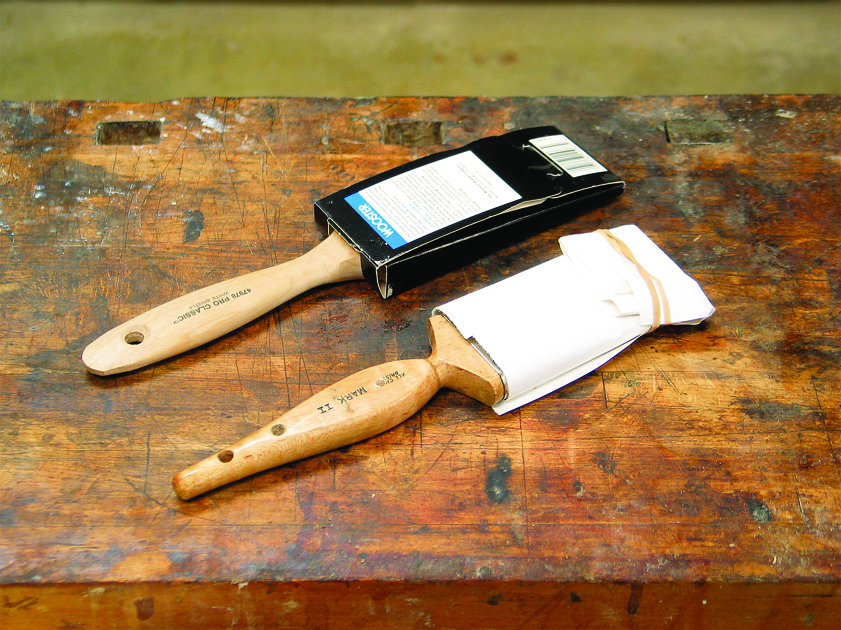
Storing clean brushes. When the bristles are clean, shake out the water and return the brush to the holder it came in or wrap the brush in paper so the bristles dry straight and stay clean. You can use a rubber band or masking tape to secure the paper.
With one section covered and the brush strokes lined up, deposit some more finish in the center of the next section and begin stretching out the finish end to end. Work this newly applied finish back into the previously applied finish before it begins to set up.
Once a finish stiffens, brushing over it will drag it and leave severe brush marks. Here’s where working fast is critical when using faster drying finishes. Working fast enough so previous strokes are still wet is called “keeping a wet edge.”
Continue working across the surface, being careful not to drip on the finish you’ve just applied. To avoid doing this, hold or place the container of finish so you aren’t swinging the brush over finished areas.
You can work from the near side to the far, or the far to the near. It doesn’t make any difference.
It’s almost always wise to sand between coats to remove dust nibs and other minor problems. Unless they are severe, use stearated #320-grit sandpaper or #400-grit Norton 3X or 3M Sandblaster sandpaper. These sandpapers are widely available at home centers and paint stores.
Brushes and Brush Marks
Cheap brushes are often blamed for brush marks, so most instructions encourage you to spend more and buy a better quality brush.
I’ve tried dozens of times over the last 20 years to confirm that it’s the quality of the brush that is responsible for the severity of brush marks, and I’ve never succeeded. It always comes down to the product itself being responsible. Some brands of varnish or water-based finish lay down level better than others.
In an effort to learn more about brushes and their possible role in causing brush marks, I once visited a large paintbrush manufacturer. The marketing director, plant manager and the technicians who designed the brushes all told me they didn’t know how to make a brush that wouldn’t leave brush marks.
They designed brushes to hold more paint or finish and to release it more evenly over the longest distance (both critical for painting large surfaces).
This confirmed what all my trials had told me. More expensive brushes feel better to use, shed bristles less and usually hold more finish. But expensive brushes don’t reduce brush marks.
Neither do foam brushes, for that matter. There’s no reason you can’t substitute a cheap, disposable foam brush for an expensive bristle brush if brush marks are your only concern.
Choosing a Brush
I find bristle brushes much more enjoyable to use, however, and choosing one is pretty easy. It comes down to paying enough to get a brush that doesn’t shed bristles (about $6 to $8 for a 2″-wide brush).
Keep in mind that natural (“China”) bristles lose their spring in water, so you should choose a synthetic (nylon or polyester) brush if you are brushing a water-based finish. Either type of brush can be used with varnish and shellac.
Cleaning Brushes
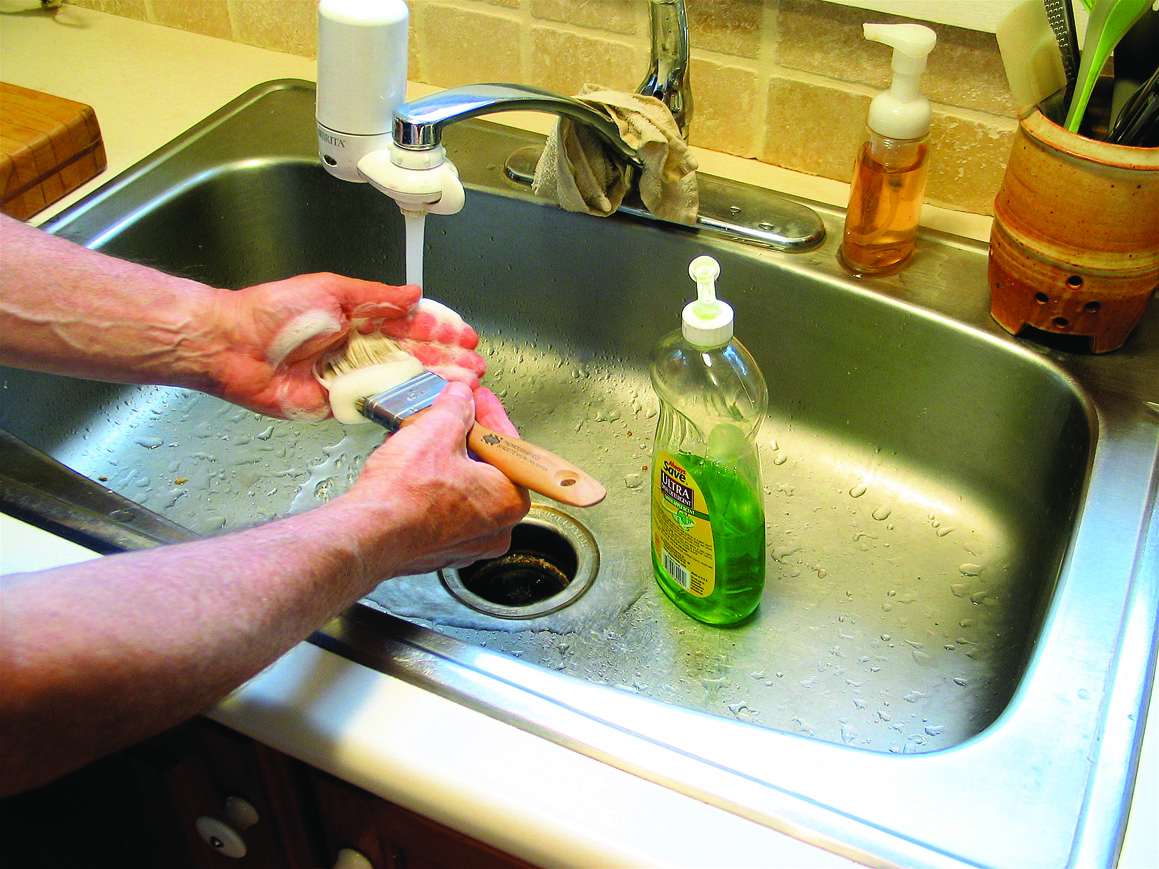
Washing a brush. After a couple of rinses in the solvent for the finish (and in lacquer thinner or brush cleaner for a varnish brush) wash the brush under a faucet. Wash until you get a lot of suds to indicate that the bristles are clean.
If you brush finishes every day, you can wrap your brush in plastic wrap or hang it overnight in the thinner for the finish. Otherwise, you should clean your brush if it is of good quality.
Clean water-based finish in the same manner as latex paint. Hold the brush under a faucet for a minute or two while spreading and massaging the bristles with your fingers. Then wash the bristles thoroughly with soap and water until you get suds.
Dishwater detergent is usually handy and is perfectly adequate.
Clean shellac by scrunching the bristles against the bottom of a jar that contains a couple inches of a mixture of about one-third household ammonia and two-thirds hot water. Then wash with soap and water.
Cleaning shellac with ammonia and water is much faster and more effective than cleaning with alcohol.
Clean alkyd or polyurethane varnish by first rinsing (scrunching) the brush in several inches of mineral spirits (paint thinner). Do this once and then at least one more time in clean mineral spirits.
Then rinse the brush in lacquer thinner or “brush cleaner.” You can use either of these for all the rinsings, but they are more expensive. Then wash in soap and water, usually two or three times until you get suds.
The purpose of the lacquer thinner or brush cleaner is to remove the oily mineral spirits so it takes fewer washings to get suds.
Finally, with the brush clean, return it to the holder it came in or wrap it in paper. This will ensure the bristles dry out straight and stay clean. You can use masking tape or a rubber band to hold the wrapping closed.
Here are some supplies and tools we find essential in our everyday work around the shop. We may receive a commission from sales referred by our links; however, we have carefully selected these products for their usefulness and quality.








